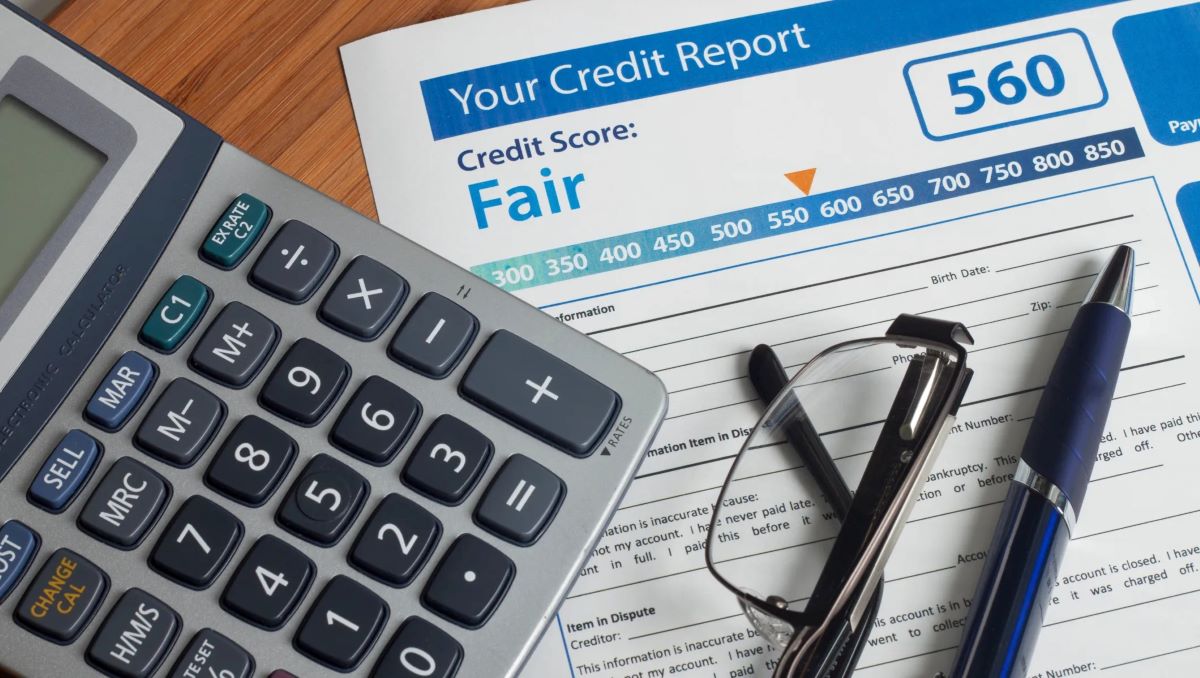Home>Finance>What Is Telecom Self-Reported On My Credit Report


Finance
What Is Telecom Self-Reported On My Credit Report
Modified: March 1, 2024
Discover what telecom self-reported on your credit report means and how it can impact your overall finance. Learn more about managing your credit and finances.
(Many of the links in this article redirect to a specific reviewed product. Your purchase of these products through affiliate links helps to generate commission for LiveWell, at no extra cost. Learn more)
Table of Contents
- Introduction
- Definition of Telecom Self-Reported
- Importance of Telecom Self-Reported on Credit Reports
- How Telecom Self-Reported Affects Credit Scores
- Factors Included in Telecom Self-Reported
- How to Interpret Telecom Self-Reported Information on Credit Reports
- How to Correct Errors in Telecom Self-Reported
- Conclusion
Introduction
When it comes to managing your finances and maintaining a good credit standing, it is crucial to have a clear understanding of the information reported on your credit report. One such piece of information that you may come across is the telecom self-reported section.
The telecom self-reported section on your credit report provides a snapshot of your telecommunications activity, including information about your phone, internet, and cable service accounts. This section may include details such as the account balance, payment history, and any past due amounts related to your telecom services.
Understanding the telecom self-reported section is important because it can have an impact on your credit score and overall creditworthiness. This article will delve into the definition of telecom self-reported, its importance on credit reports, how it affects credit scores, the factors considered in telecom self-reported, how to interpret the information, and steps to correct any errors that might arise.
By gaining a comprehensive understanding of the telecom self-reported section on your credit report, you will be better equipped to manage your finances, make informed credit-related decisions, and ensure the accuracy of the information reported.
Definition of Telecom Self-Reported
Telecom self-reported refers to the section on your credit report that contains information regarding your telecommunications accounts. It includes details about your phone, internet, and cable service providers, as well as any associated financial obligations.
This section provides a comprehensive snapshot of your telecom activity and may include various data points, such as:
- Account balance: The amount you owe to your telecom service provider.
- Payment history: A record of your past payments, including any missed or late payments.
- Past due amounts: Any outstanding payments that are overdue.
- Collection accounts: If your telecom account has been sent to collections due to non-payment, it will be reflected in this section.
- Account status: This indicates whether the account is open, closed, or in default.
Telecom self-reported information is collected and reported by telecommunication companies to credit bureaus. Credit bureaus, such as Experian, Equifax, and TransUnion, gather this data and include it in your credit report.
It’s important to note that the telecom self-reported section may also include information related to utility bills, such as gas, electric, or water accounts, depending on the reporting practices of the specific telecommunication company.
By having access to this information, lenders and creditors can assess your creditworthiness and make informed decisions when considering your application for credit or a loan. Understanding the details included in your telecom self-reported section is crucial for managing your financial health and ensuring the accuracy of the information reported.
Importance of Telecom Self-Reported on Credit Reports
The telecom self-reported section on your credit report plays a significant role in determining your creditworthiness and financial standing. It provides valuable insight into your payment behavior and level of responsibility when it comes to managing your telecom accounts. Here are some key reasons why the telecom self-reported section is important on credit reports:
1. Impact on Credit Scores:
Telecom self-reported information can have an impact on your credit scores. Late payments, outstanding balances, or collection accounts reported in this section can negatively affect your credit scores, making it harder to get approved for credit cards, loans, or favorable interest rates. Conversely, a positive payment history and responsible account management can contribute to higher credit scores.
2. Lender Consideration:
When you apply for credit, lenders and creditors review your credit report to assess your creditworthiness. The telecom self-reported section provides them with crucial information about your payment behavior and financial obligations. A history of missed payments or outstanding balances may raise concerns for lenders, potentially leading to credit denials or unfavorable loan terms.
3. Overall Financial Health:
The telecom self-reported section is a reflection of your overall financial health. It shows how effectively you manage your telecom accounts, including your ability to make timely payments and handle any outstanding balances. Maintaining a positive telecom self-reported section indicates responsible financial habits and can be beneficial when applying for other forms of credit or negotiating better terms.
4. Potential Red Flags:
Errors or discrepancies in the telecom self-reported section can be red flags for identity theft or reporting inaccuracies. Regularly reviewing this section allows you to identify and correct any errors promptly. It also gives you the opportunity to spot any fraudulent activity that may impact your credit standing.
Understanding the importance of the telecom self-reported section on your credit report empowers you to take control of your financial health. By maintaining a positive payment history and promptly addressing any discrepancies or errors in this section, you can improve your creditworthiness and increase your chances of obtaining credit on favorable terms.
How Telecom Self-Reported Affects Credit Scores
The telecom self-reported section on your credit report can have a significant impact on your credit scores. It highlights your payment behavior and financial responsibility when it comes to managing your telecommunications accounts. Here are some ways in which the telecom self-reported section can affect your credit scores:
1. Payment History:
Your payment history is one of the most important factors in determining your credit scores. The telecom self-reported section reflects your payment behavior, including any late payments or missed payments. Consistently making on-time payments on your telecom accounts can positively impact your credit scores, while late or missed payments can have a negative effect.
2. Account Balances:
The amount you owe on your telecom accounts, as shown in the telecom self-reported section, can also impact your credit scores. If you have high balances or maxed-out credit limits on your telecom accounts, it can negatively affect your credit scores. Keeping your account balances low and within a manageable range demonstrates responsible credit utilization, which can help boost your credit scores.
3. Collection Accounts:
If your telecom account becomes severely delinquent and is sent to collections, it will be reflected in the telecom self-reported section. Collection accounts can have a significant negative impact on your credit scores. They indicate a failure to repay debt and can remain on your credit report for up to seven years, dragging down your credit scores.
4. Credit Utilization:
Your telecom accounts, just like other credit accounts, contribute to your overall credit utilization. Credit utilization refers to the percentage of your available credit that you are currently using. A high credit utilization ratio can lower your credit scores, while a low ratio can have a positive impact. Therefore, managing your telecom accounts responsibly and keeping your credit utilization low can help improve your credit scores.
5. Consistency and Length of Credit History:
The telecom self-reported section provides information about the length of time you have had your telecom accounts. Credit bureaus consider the age of your credit accounts as a factor in determining your credit scores. Having long-standing telecom accounts with a positive payment history demonstrates stability and can positively impact your credit scores.
It’s essential to understand that the impact of the telecom self-reported section on credit scores is not isolated. It is interlinked with other factors on your credit report, such as payment history, credit utilization, and the presence of any negative information. Maintaining a positive telecom self-reported section and managing your telecommunications accounts responsibly can contribute to building and maintaining healthy credit scores.
Factors Included in Telecom Self-Reported
The telecom self-reported section on your credit report contains various factors that provide insight into your telecommunications accounts. These factors help lenders and creditors assess your creditworthiness and make informed decisions when considering your application for credit or a loan. Here are some key factors included in the telecom self-reported section:
1. Account Information:
The telecom self-reported section includes details about your telecom accounts, such as the name of the telecom service provider, the type of service (phone, internet, cable), and the account number. This information helps identify the specific telecom accounts being reported on your credit report.
2. Account Balance:
The telecom self-reported section shows the outstanding balance of your telecom accounts. This includes any payments you owe to your telecom service provider. A high balance could indicate a significant financial obligation and can impact your creditworthiness.
3. Payment History:
Payment history is a critical factor in the telecom self-reported section. It reflects your payment behavior on your telecom accounts, including whether you paid your bills on time or had any late or missed payments. A history of on-time payments reflects positively on your creditworthiness, while late payments can have a negative impact.
4. Past Due Amounts:
The telecom self-reported section also includes information about any past due amounts or overdue payments on your telecom accounts. This indicates any outstanding balances that have not been settled within the specified payment period. Past due amounts can negatively impact your creditworthiness.
5. Collection Accounts:
If your telecom account has been sent to collections due to non-payment, it will be reported in this section. Collection accounts can have a severely negative impact on your credit scores and indicate a failure to repay debt.
6. Account Status:
This section indicates the status of your telecom accounts, whether they are open, closed, or in default. An account in default signifies non-payment or severe delinquency, which can significantly impact your creditworthiness.
It’s important to note that the specific factors included in the telecom self-reported section may vary depending on the reporting practices of the telecom service providers and the credit bureaus. Reviewing this section carefully can provide valuable insight into your telecommunications accounts and allow you to monitor your payment behavior and account status accurately.+
How to Interpret Telecom Self-Reported Information on Credit Reports
Interpreting the telecom self-reported information on your credit report is essential for understanding your financial standing and creditworthiness. Here are some tips on how to interpret the telecom self-reported section:
1. Review Account Information:
Start by carefully reviewing the account information provided in the telecom self-reported section. Look for accurate identification of the telecom service provider, the type of service, and the account number. Ensure that the information matches your actual telecom accounts.
2. Analyze Account Balances:
Pay attention to the outstanding balances listed in the telecom self-reported section. High balances can indicate a significant financial obligation. If you have consistently high balances, it may be a sign that you need to reevaluate your budget and payment strategies to decrease your debt burden.
3. Evaluate Payment History:
Assess your payment history on your telecom accounts. Look for patterns of on-time payments, late payments, or missed payments. A history of on-time payments demonstrates responsible financial behavior, while late or missed payments can signal financial volatility or difficulty in managing your obligations.
4. Note Past Due Amounts:
If there are any past due amounts mentioned in the telecom self-reported section, take note of them. Past due amounts indicate outstanding balances that have not been paid within the designated timeframe. Addressing these overdue payments promptly can help improve your creditworthiness.
5. Identify Collection Accounts:
If there are any collection accounts listed in the telecom self-reported section, it is crucial to address them. Collection accounts can have a severe negative impact on your credit scores. Take steps to resolve these accounts and ensure that they are accurately reported.
6. Understand Account Status:
Review the account status of your telecom accounts mentioned in this section. Look for any accounts that are marked as closed or in default. Closed accounts should indicate a successful closure of the account, while accounts in default signify non-payment or severe delinquency.
Interpreting the telecom self-reported information on your credit report allows you to gain insight into your telecommunications accounts and assess your creditworthiness. By understanding the details provided in this section, you can identify areas for improvement, address any discrepancies, and make informed financial decisions.
How to Correct Errors in Telecom Self-Reported
If you come across any errors in the telecom self-reported section of your credit report, it is crucial to take steps to correct them promptly. Incorrect information can negatively impact your creditworthiness and hinder your ability to obtain credit on favorable terms. Here are the steps to correct errors in the telecom self-reported section:
1. Obtain a Copy of Your Credit Report:
Start by obtaining a copy of your credit report from each of the major credit bureaus – Experian, Equifax, and TransUnion. You are entitled to a free copy of your credit report once every 12 months under federal law. Review the telecom self-reported section in each report to identify any errors.
2. Document the Errors:
Make a note of each error you identified in the telecom self-reported section. Be specific about the incorrect information, such as incorrect account balance, missed payments that were made on time, or accounts that are not yours. Documenting the errors will help you communicate effectively with the credit bureaus and telecom service providers.
3. Contact the Credit Bureau:
Initiate contact with the credit bureau that has reported the errors. The contact information is usually provided on your credit report. Submit a dispute letter to the credit bureau, clearly outlining the errors you identified in the telecom self-reported section. Include any supporting documentation that substantiates your claim, such as payment receipts or account statements.
4. Contact the Telecom Service Provider:
Simultaneously, get in touch with the telecom service provider that has reported the incorrect information. Provide them with the details of the errors and request that they update the information with the credit bureaus. They may require documentation or additional information to rectify the errors. Follow up with them to track the progress of the correction.
5. Monitor Your Credit Report:
Regularly monitor your credit report to check for updates, ensuring that the errors in the telecom self-reported section have been corrected. The credit bureaus are required to investigate and respond to your dispute within 30-45 days. If the errors persist or the credit bureaus do not take appropriate action, consider filing a complaint with the Consumer Financial Protection Bureau.
6. Maintain Documentation:
Throughout the process, keep records of all communication, including copies of dispute letters, emails, and supporting documentation. Having a documented trail will be useful if you need to escalate the matter or provide evidence of your efforts to correct the errors.
It’s crucial to act promptly when you identify errors in the telecom self-reported section of your credit report. By taking the necessary steps to correct the errors, you can ensure the accuracy of your credit report and protect your creditworthiness.
Conclusion
Understanding the telecom self-reported section on your credit report is crucial for managing your financial health and ensuring the accuracy of the information reported. This section provides valuable insights into your telecommunications accounts, including payment history, outstanding balances, and account status. It plays a significant role in determining your creditworthiness and can impact your credit scores.
By maintaining a positive telecom self-reported section, such as making on-time payments and keeping account balances low, you can improve your credit scores and increase your chances of obtaining credit on favorable terms. It is equally important to monitor this section for any errors and take prompt action to correct them. Errors in the telecom self-reported section can negatively impact your creditworthiness and hinder your financial goals.
To correct errors, obtain a copy of your credit report, document the inaccuracies, and contact both the credit bureau and the telecom service provider to initiate the dispute process. Monitor your credit report regularly to ensure the errors have been rectified.
In conclusion, a clear understanding of the telecom self-reported section on your credit report empowers you to make informed financial decisions and take control of your creditworthiness. By managing your telecommunications accounts responsibly, addressing any errors promptly, and maintaining a positive payment history, you can build a strong credit profile and achieve your financial goals.














